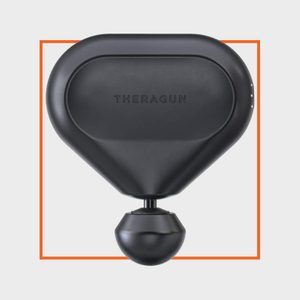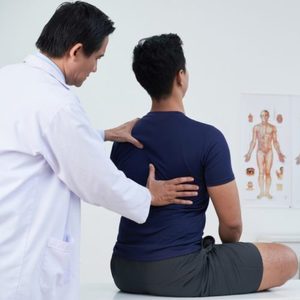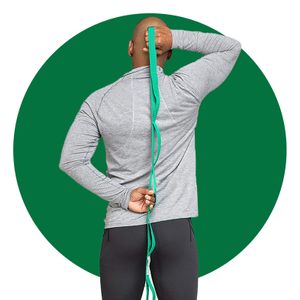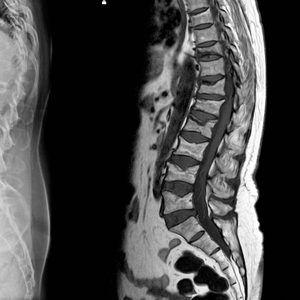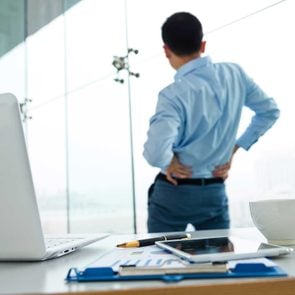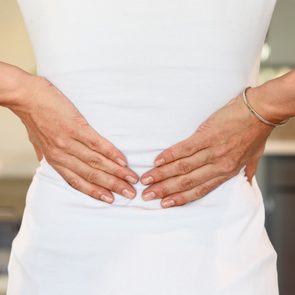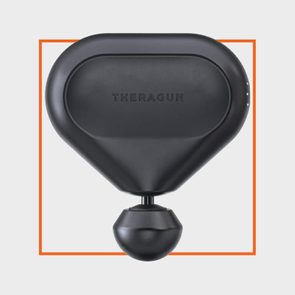What Causes Sharp Lower Back Pain?
Updated: Mar. 11, 2022
There are many causes for sharp lower back pain, from muscle spasms to a fracture. Here are the tips and tools to help you feel better faster.
Understanding sharp lower back pain
If you have ever been sidelined by sharp lower back pain—and odds are, you have been or will be at some point—you know just how debilitating it can be. About 80 percent of people will have battle back pain at some point in their lives, according to the National Library of Medicine.
Low back pain can be sharp, marked by throbbing and pressure, or dull and constant, says Krishna Shah, MD, assistant professor, anesthesiology and interventional pain medicine, Baylor College of Medicine in Houston. This pain may be acute (lasting four to 12 weeks) or chronic (lasting 12 weeks or more). There are many potential causes for sharp low back pain, including an accident or trauma to your back, lifting something the wrong way, an underlying disease or condition, and advancing age.
(These are signs that your back pain is an emergency.)
Your chances of experiencing sharp low back pain are greater if you’re overweight or obese, smoke, and are not physically active on a regular basis. If you are a weekend warrior—and a weekday couch potato—you may be more likely to injure your back trying to keep up with your peers. Genetics can also play a role.
(Here’s how your brain helps with low back pain.)
What exactly is your lower back?
Your lower back comprises five vertebrae (L1 to L5). These help support your upper body. Discs, which serve as shock absorbers, are found between each vertebra. “There are so many structures in your lower back that can cause or contribute to pain, including muscles, soft connective tissue, ligaments, blood vessels, nerves, joints, discs, and bones,” says Jake Magel, a physical therapist and research assistant professor at the University of Utah in Salt Lake City.
Diagnosing sharp low back pain
Given all the potential causes of sharp low back pain, some detective work is usually needed to find out what’s going on, Dr. Shah says.
“We start by doing a physical exam and taking a thorough history,” he says. “We want to know what happened, when the pain started, if the pain is getting better or worse, if it radiates downward and causes neurologic symptoms such as numbness and tingling, and if it is specific to one spot on your back.” (Learn how to use a pain scale to assess your pain.)
Your doctor may order a plain X-ray and/or more advanced imaging tests to see if there is an identifiable and visible cause for your back pain, he says. “Most back pain is called nonspecific because there is not an identifiable structure,” Magel adds.
Is it a fracture?
Symptoms of a fracture in your lower back may include tenderness and sharp pain, often in your middle or lower back, Dr. Shah says. They can be caused by trauma to the area. If your bones are brittle due to osteoporosis, he says even just a minor fall can result in a fracture.
Treatment
Once your doctor confirms a fracture with a physical exam and some imaging tests, the first line of therapy is usually medications to relieve your pain, Dr. Shah says. This starts with non-steroidal anti-inflammatory drugs (NSAIDs). Based on the degree of pain or presence of nerve involvement, there are also stronger medications to choose from, he says. Steroid injections can help relieve this pain, as well, he says.
A minimally invasive procedure known as kyphoplasty is another option. It is mainly for fracture of the vertebral body due to osteoporosis. During this procedure, your doctor is guided by X-ray to insert a needle into the fractured area. Your doctor then inflates a balloon-like device to make space and fills it with bone cement to restore height and reduce pain. “Surgery is always the absolute last resort,” he says.
Is it an infection?
Signs of infection of the internal structures of the lower back may include fever and a warm area on the back. And these infections may be carried into the spine through the bloodstream from other parts of the body. A blood test and imaging such as MRI or CAT scan can usually tell if you have an infection, Dr. Shah says. If an infection is responsible for your sharp low back pain, antibiotics are given via infusion in the hospital, he says.
“How well antibiotics work really depends on how early you catch it and whether it becomes an infection of the bone, which that can be difficult to treat,” he says.
After these red flags are ruled out, your doctor can consider other causes of your sharp low back pain.
“Most common and less serious causes of back pain can be caused by muscle strain, disc herniations, degenerative arthritis, or when all of these come together from decades of wear and tear to cause something called lumbar spinal stenosis,” says Yili Huang, director of the Pain Management Center at Northwell Health’s Phelps Hospital, in Sleepy Hollow, New York. “Sometimes nerves are pinched as they come out from the spine in the lower back and cause pain shooting to the buttock, hip, or legs,” she says of the conditions known as radiculopathy (pinched nerve) and sciatica.
(Here’s how one woman with a herniated disc used mind-body exercises to heal.)
Herniated or bulging disc
If a disc slips out of place, it can press on spinal nerves, often producing pain, which may be severe and cause sciatica, Dr. Shah says. Sciatica can cause sharp, shock-like pain and also cause tingling, weakness, and numbness in your legs, he explains.
Treatment
Treatment starts with conservative care, including NSAIDs if the pain is mild plus physical therapy, Dr. Shah explains. “We may also try injections,” he says. Bed rest is no longer recommended for low back pain, he notes. “Instead, we want people to remain active while healing. For the most part, if you do physical therapy and try medication and/or injections, your pain should subside within six to eight weeks.”
(These types of exercise may help with low back pain.)
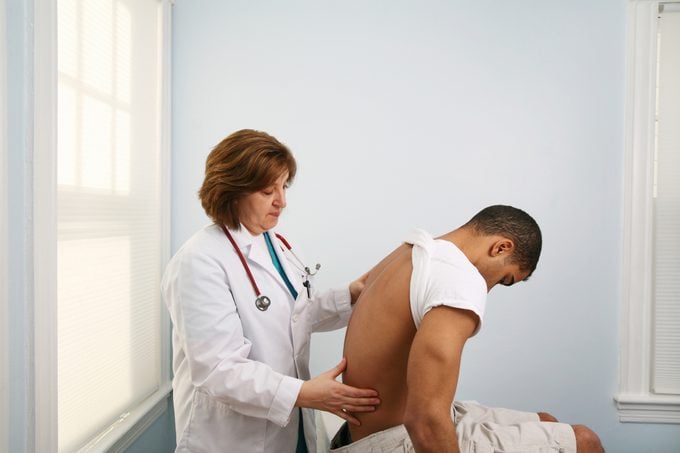
Muscle spasms
These come on fast and furious when your back muscles involuntarily contract. This may happen when you bend, twist or lift something heavy, says Magel.
Treatment
“A physical therapist will help develop a treatment plan that may include spinal manipulation, exercise, and education about pain,” he says. With spinal manipulation, the therapist will use their hands or a device to apply a controlled thrust to the painful area.”Generally, it’s an active approach and patients gradually and progressively resume activity as soon as possible,” Magel says.
(You can try these best back massagers for lower back pain.)
Spinal stenosis
When a narrowing of your spine puts pressure on your nerves and spinal cord, it can cause sharp low back pain and sometimes weakness or numbness. Often the leg symptoms come on while walking and are relieved quickly by sitting down.
Treatment
“Regular exercise, medication or injections, and in some cases surgery can provide relief,” Shah says, adding that surgery is always the last resort. This may occur as a result of the wear and tear of osteoarthritis.
(Learn more about lower back pain relief.)
Arthritis
Ankylosing spondylitis is an autoimmune disease in which your body misfires against the hip joint and the sacroiliac joint that connects your pelvis and lower spine, causing pain and severe stiffness. Other types of arthritis, including osteoarthritis and psoriatic arthritis, cause low back pain, too.
Treatment
Low back pain from arthritis can usually be treated with NSAIDs or other painkillers. It can also be treated with drugs that modulate your immune system. However, this is only if the pain is caused by psoriatic arthritis or ankylosing spondylitis.
(These are the best CBD oils for arthritis.)
Other causes of sharp low back pain
Sometimes the sharp pain you are feeling in your back comes from somewhere else—possibly kidney stones, endometriosis, widespread muscle pain and fatigue, fibromyalgia, or tumors. Pregnancy can also cause back pain from carrying around all of the extra weight. Some people are born with spine abnormalities like spina bifida which can cause low back pain.
(Check out the best mattresses for lower back pain.)
The last word
There are many potential causes of sharp low back pain. The first step toward relief is finding out what is causing yours. Available treatments—from NSAIDs and other medications to steroid injections and physical therapy—can help treat pain and prevent it from coming back. Most of the time you will feel better within four to six weeks, Dr. Shah says.
(Also, try these exercises for lower back pain.)























